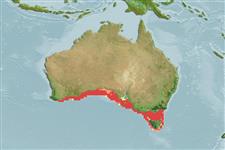Élasmobranches (requins et raies) (sharks and rays) >
Orectolobiformes (Carpet sharks) >
Parascylliidae (Collared carpet sharks)
Etymology: Parascyllium: para (Gr.), near, i.e., presumed to be related to Scyliorhinus (now in Scyliorhinidae): skylion, Greek for dogfish or small shark (See ETYFish); ferrugineum: Latin for rust-colored, referring to dark brown spots on sides and fins (See ETYFish).
Environment: milieu / climate zone / depth range / distribution range
Écologie
marin démersal; profondeur 5 - 150 m (Ref. 6871). Temperate; 31°S - 45°S, 117°E - 149°E (Ref. 54700)
Eastern Indian Ocean: endemic to Australia.
Length at first maturity / Taille / Poids / Âge
Maturity: Lm ?, range 60 - ? cm
Max length : 80.0 cm TL mâle / non sexé; (Ref. 6871)
Found on the continental shelf; on or near the bottom; also close inshore near rocks and river mouths. Occurs on beds of algae on reefs or seagrass; also hides in rocky caves and ledges during the day. Feeds on bottom-dwelling crustaceans and molluscs (Ref. 43278). Oviparous (Ref. 6871, 43278).
Life cycle and mating behavior
Maturité | Reproduction | Frai | Œufs | Fécondité | Larves
Oviparous, paired eggs are laid. Embryos feed solely on yolk (Ref. 50449).
Compagno, L.J.V., 1984. FAO Species Catalogue. Vol. 4. Sharks of the world. An annotated and illustrated catalogue of shark species known to date. Part 1 - Hexanchiformes to Lamniformes. FAO Fish. Synop. 125(4/1):1-249. Rome, FAO. (Ref. 247)
Statut dans la liste rouge de l'IUCN (Ref. 130435: Version 2024-2)
Menace pour l'homme
Harmless
Utilisations par l'homme
Pêcheries: sans intérêt
Outils
Articles particuliers
Télécharger en XML
Sources Internet
Estimates based on models
Preferred temperature (Ref.
123201): 14.6 - 18.3, mean 16.8 °C (based on 158 cells).
Phylogenetic diversity index (Ref.
82804): PD
50 = 0.5352 [Uniqueness, from 0.5 = low to 2.0 = high].
Bayesian length-weight: a=0.00389 (0.00180 - 0.00842), b=3.12 (2.94 - 3.30), in cm total length, based on all LWR estimates for this body shape (Ref.
93245).
Niveau trophique (Ref.
69278): 3.7 ±0.6 se; based on size and trophs of closest relatives
Résilience (Ref.
120179): Faible, temps minimum de doublement de population : 4,5 à 14 années (Fec assumed to be <100).
Fishing Vulnerability (Ref.
59153): Moderate to high vulnerability (52 of 100).
Nutrients (Ref.
124155): Calcium = 13 [3, 58] mg/100g; Iron = 0.259 [0.069, 0.730] mg/100g; Protein = 18.8 [16.7, 20.8] %; Omega3 = 0.412 [0.185, 0.897] g/100g; Selenium = 11.8 [3.6, 31.5] μg/100g; VitaminA = 10.5 [3.3, 31.9] μg/100g; Zinc = 0.442 [0.215, 0.796] mg/100g (wet weight);
